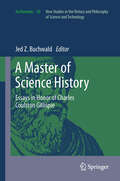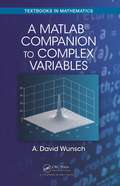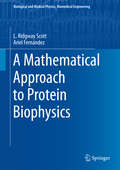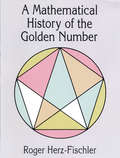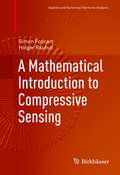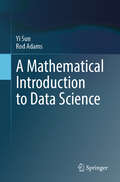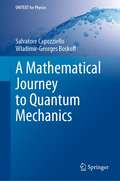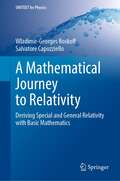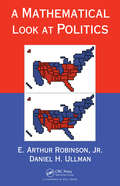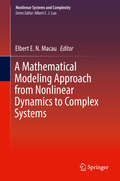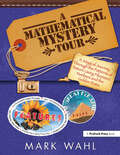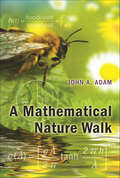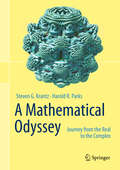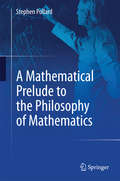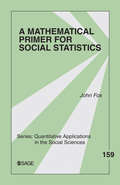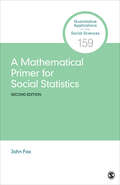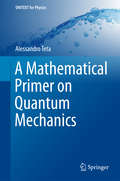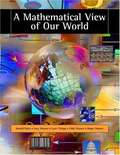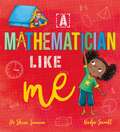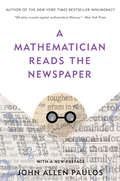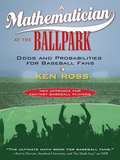- Table View
- List View
A Master of Science History: Essays in Honor of Charles Coulston Gillispie (Archimedes #30)
by Jed Z. BuchwaldNew essays in science history ranging across the entire field and related in most instance to the works of Charles Gillispie, one of the field's founders.
A MatLab Companion to Complex Variables (Textbooks in Mathematics #41)
by A. David WunschThis book is intended for someone learning functions of a complex variable and who enjoys using MATLAB. It will enhance the exprience of learning complex variable theory and will strengthen the knowledge of someone already trained in ths branch of advanced calculus. ABET, the accrediting board for engineering programs, makes it clear that engineering graduates must be skilled in the art of programming in a language such as MATLAB®. Supplying students with a bridge between the functions of complex variable theory and MATLAB, this supplemental text enables instructors to easily add a MATLAB component to their complex variables courses.A MATLAB® Companion to Complex Variables provides readers with a clear understanding of the utility of MATLAB in complex variable calculus. An ideal adjunct to standard texts on the functions of complex variables, the book allows professors to quickly find and assign MATLAB programming problems that will strengthen students’ knowledge of the language and concepts of complex variable theory.The book shows students how MATLAB can be a powerful learning aid in such staples of complex variable theory as conformal mapping, infinite series, contour integration, and Laplace and Fourier transforms. In addition to MATLAB programming problems, the text includes many examples in each chapter along with MATLAB code.Fractals, the most recent interesting topic involving complex variables, demands to be treated with a language such as MATLAB. This book concludes with a Coda, which is devoted entirely to this visually intriguing subject.MATLAB is not without constraints, limitations, irritations, and quirks, and there are subtleties involved in performing the calculus of complex variable theory with this language. Without knowledge of these subtleties, engineers or scientists attempting to use MATLAB for solutions of practical problems in complex variable theory suffer the risk of making major mistakes. This book serves as an early warning system about these pitfalls.
A Mathematica Primer for Physicists (Textbook Series in Physical Sciences)
by Jim Napolitano<P>Learn how to use Mathematica quickly for basic problems in physics. The author introduces all the key techniques and then shows how they’re applied using common examples. Chapters cover elementary mathematics concepts, differential and integral calculus, differential equations, vectors and matrices, data analysis, random number generation, animation, and visualization. <P>Written in an appealing, conversational style <br>Presents important concepts within the framework of Mathematics <br>Gives examples from frequently encountered physics problems <br>Explains problem-solving in a step-by-step fashion ?<P>Jim Napolitano is professor and chair in the Department of Physics at Temple University.
A Mathematical Approach to Protein Biophysics (Biological and Medical Physics, Biomedical Engineering)
by L. Ridgway Scott Ariel FernándezThis book explores quantitative aspects of protein biophysics and attempts to delineate certain rules of molecular behavior that make atomic scale objects behave in a digital way. This book will help readers to understand how certain biological systems involving proteins function as digital information systems despite the fact that underlying processes are analog in nature. The in-depth explanation of proteins from a quantitative point of view and the variety of level of exercises (including physical experiments) at the end of each chapter will appeal to graduate and senior undergraduate students in mathematics, computer science, mechanical engineering, and physics, wanting to learn about the biophysics of proteins. L. Ridgway Scott has been Professor of Computer Science and of Mathematics at the University of Chicago since 1998, and the Louis Block Professor since 2001. He obtained a B. S. degree (Magna Cum Laude) from Tulane University in 1969 and a PhD degree in Mathematics from the Massachusetts Institute of Technology in 1973. Professor Scott has published over 130 papers and three books, extending over biophysics, parallel computing and fundamental computing aspects of structural mechanics, fluid dynamics, nuclear engineering, and computational chemistry. Ariel Fern#65533;ndez (born Ariel Fern#65533;ndez Stigliano) is an Argentinian-American physical chemist and mathematician. He obtained his Ph. D. degree in Chemical Physics from Yale University and held the Karl F. Hasselmann Endowed Chair Professorship in Bioengineering at Rice University. He is currently involved in research and entrepreneurial activities at various consultancy firms. Ariel Fern#65533;ndez authored three books on translational medicine and biophysics, and published 360 papers in professional journals. He holds two patents in the field of biotechnology.
A Mathematical History of the Golden Number
by Roger Herz-FischlerThe first complete, in-depth study of the origins of division in extreme and mean ratio (DEMR)-"the Golden Number"-this text charts every aspect of this important mathematical concept's historic development, from its first unequivocal appearance in Euclid's Elements through the 18th century.Readers will find a detailed analysis of the role of DEMR in the Elements and of its historical implications. This is followed by a discussion of other mathematical topics and of proposals by modern commentators concerning the relationship of these concepts to DEMR. Following chapters discuss the Pythagoreans, examples of the pentagram before 400 H.C., and the writings of pre-Euclidean mathematicians. The author then presents his own controversial views on the genesis, early development and chronology of DEMR. The second half of the book traces DEMR's post-Euclidean development through the later Greek period, the Arabic world, India, and into Europe. The coherent but rigorous presentation places mathematicians' work within the context of their time and dearly explains the historical transmission of their results. Numerous figures help clarify the discussions, a helpful guide explains abbreviations and symbols, and a detailed appendix defines terminology for DEMR through the ages.This work will be of interest not only to mathematicians but also to classicists, archaeologists, historians of science and anyone interested in the transmission of mathematical ideas. Preface to the Dover Edition. Foreword. A Guide for Readers. Introduction. Appendixes. Corrections and Additions. Bibliography.
A Mathematical Introduction to Compressive Sensing (Applied and Numerical Harmonic Analysis)
by Holger Rauhut Simon FoucartFilling a significant gap in the literature, A Mathematical Introduction to Compressive Sensing is the first work entirely devoted to the thriving field of compressive sensing. The book clearly and comprehensively presents the essential theory of compressive sensing from a mathematical perspective. Featuring a substantial number of exercises with hints to solutions, as well as MATLAB codes for algorithms and simulations, the work is well suited for graduate courses on the subject. With only moderate mathematical prerequisites, this volume is a reliable resource for graduate students, practioners, and researchers in engineering, computer science, and mathematics looking to acquire a careful understanding of compressive sensing.
A Mathematical Introduction to Data Science
by Yi Sun Rod AdamsThis textbook provides a comprehensive foundation in the mathematics needed for data science for students and self-learners with a basic mathematical background who are interested in the principles behind computational algorithms in data science. It covers sets, functions, linear algebra, and calculus, and delves deeply into probability and statistics, which are key areas for understanding the algorithms driving modern data science applications. Readers are guided toward unlocking the secrets of algorithms like Principal Component Analysis, Singular Value Decomposition, Linear Regression in two and more dimensions, Simple Neural Networks, Maximum Likelihood Estimation, Logistic Regression and Ridge Regression, illuminating the path from mathematical principles to algorithmic mastery. It is designed to make the material accessible and engaging, guiding readers through a step-by-step progression from basic mathematical concepts to complex data science algorithms. It stands out for its emphasis on worked examples and exercises that encourage active participation, making it particularly beneficial for those with limited mathematical backgrounds but a strong desire to learn. This approach facilitates a smoother transition into more advanced topics. The authors expect readers to be proficient in handling numbers in various formats, including fractions, decimals, percentages, and surds. They should also have a knowledge of introductory algebra, such as manipulating simple algebraic expressions, solving simple equations, and graphing elementary functions, along with a basic understanding of geometry including angles, trigonometry and Pythagoras’ theorem.
A Mathematical Journey to Quantum Mechanics (UNITEXT for Physics)
by Wladimir-Georges Boskoff Salvatore CapozzielloThis book provides an itinerary to quantum mechanics taking into account the basic mathematics to formulate it. Specifically, it features the main experiments and postulates of quantum mechanics pointing out their mathematical prominent aspects showing how physical concepts and mathematical tools are deeply intertwined. The material covers topics such as analytic mechanics in Newtonian, Lagrangian, and Hamiltonian formulations, theory of light as formulated in special relativity, and then why quantum mechanics is necessary to explain experiments like the double-split, atomic spectra, and photoelectric effect. The Schrödinger equation and its solutions are developed in detail. It is pointed out that, starting from the concept of the harmonic oscillator, it is possible to develop advanced quantum mechanics. Furthermore, the mathematics behind the Heisenberg uncertainty principle is constructed towards advanced quantum mechanical principles. Relativistic quantum mechanics is finally considered.The book is devoted to undergraduate students from University courses of Physics, Mathematics, Chemistry, and Engineering. It consists of 50 self-contained lectures, and any statement and theorem are demonstrated in detail. It is the companion book of "A Mathematical Journey to Relativity", by the same Authors, published by Springer in 2020.
A Mathematical Journey to Relativity: Deriving Special and General Relativity with Basic Mathematics (UNITEXT for Physics)
by Wladimir-Georges Boskoff Salvatore CapozzielloThis book opens with an axiomatic description of Euclidean and non-Euclidean geometries. Euclidean geometry is the starting point to understand all other geometries and it is the cornerstone for our basic intuition of vector spaces. The generalization to non-Euclidean geometry is the following step to develop the language of Special and General Relativity. These theories are discussed starting from a full geometric point of view. Differential geometry is presented in the simplest way and it is applied to describe the physical world. The final result of this construction is deriving the Einstein field equations for gravitation and spacetime dynamics. Possible solutions, and their physical implications are also discussed: the Schwarzschild metric, the relativistic trajectory of planets, the deflection of light, the black holes, the cosmological solutions like de Sitter, Friedmann-Lemaître-Robertson-Walker, and Gödel ones. Some current problems like dark energy are also scketched. The book is self-contained and includes details of all proofs. It provides solutions or tips to solve problems and exercises. It is designed for undergraduate students and for all readers who want a first geometric approach to Special and General Relativity.
A Mathematical Journey to Relativity: Deriving Special and General Relativity with Basic Mathematics (UNITEXT for Physics)
by Wladimir-Georges Boskoff Salvatore CapozzielloThe 2nd edition of this textbook features more than 100 pages of new material, including four new chapters, as well as an improved discussion of differential geometry concepts and their applications. The textbook aims to provide a comprehensive geometric description of Special and General Relativity, starting from basic Euclidean geometry to more advanced non-Euclidean geometry and differential geometry. Readers will learn about the Schwarzschild metric, the relativistic trajectory of planets, the deflection of light, the black holes, and the cosmological solutions like de Sitter, Friedman-Lemaître-Robertson-Walker, and Gödel ones, as well as the implications of each of them for the observed physical world. In addition, the book provides step-by-step solutions to problems and exercises, making it an ideal introduction for undergraduate students and readers looking to gain a better understanding of Special and General Relativity. In this new edition, a wide discussion on metric-affine theories of gravity and equivalent formulations of General Relativity is reported. The aim is presenting also topics which could be useful for PhD students and researchers studying General Relativity from an advanced point of view.
A Mathematical Look at Politics
by E. Arthur Robinson Jr. Daniel H. UllmanWhat Ralph Nader's spoiler role in the 2000 presidential election tells us about the American political system. Why Montana went to court to switch the 1990 apportionment to Dean's method. How the US tried to use game theory to win the Cold War, and why it didn't work. When students realize that mathematical thinking can address these sorts of pres
A Mathematical Modeling Approach from Nonlinear Dynamics to Complex Systems (Nonlinear Systems and Complexity #22)
by Elbert E. MacauThis book collects recent developments in nonlinear and complex systems. It provides up-to-date theoretic developments and new techniques based on a nonlinear dynamical systems approach that can be used to model and understand complex behavior in nonlinear dynamical systems. It covers symmetry groups, conservation laws, risk reduction management, barriers in Hamiltonian systems, and synchronization and chaotic transient. Illustrating mathematical modeling applications to nonlinear physics and nonlinear engineering, the book is ideal for academic and industrial researchers concerned with machinery and controls, manufacturing, and controls.· Introduces new concepts for understanding and modeling complex systems;· Explains risk reduction management in complex systems;· Examines the symmetry group approach to understanding complex systems;· Illustrates the relation between transient chaos and crises.
A Mathematical Mystery Tour: Higher-Thinking Math Tasks (Grades 5-12)
by Mark WahlA Mathematical Mystery Tour has been used by thousands of students and has inspired adults to greater appreciation of the secret number language of nature. It is multidisciplinary, visual, and hands-on, practicing skills while also requiring deep math thinking. The activities are reproducible and each is accompanied with informational teacher pages giving answers, historical notes, teacher suggestions, and activity extensions.Let this geographically alive Mystery Tour integrate math with art, science, philosophy, history, social studies, and language arts. The use of the calculator, geometric construction, metric measurement, problem solving, formulating results, building models and making inferences is woven throughout the book.Each book purchase includes a link to a downloadable student newspaper, the Mathematical Mystery Tour Guide, coordinated with the book content. It is capable of being broken up into various assignments and handed out as print or sent whole electronically to each student. It is filled with games, riddles, dramatic historical information, crosswords, provocative questions, and additional math thought activities.
A Mathematical Nature Walk
by John A. AdamHow heavy is that cloud? Why can you see farther in rain than in fog? Why are the droplets on that spider web spaced apart so evenly? If you have ever asked questions like these while outdoors, and wondered how you might figure out the answers, this is a book for you. An entertaining and informative collection of fascinating puzzles from the natural world around us, A Mathematical Nature Walk will delight anyone who loves nature or math or both. John Adam presents ninety-six questions about many common natural phenomena--and a few uncommon ones--and then shows how to answer them using mostly basic mathematics. Can you weigh a pumpkin just by carefully looking at it? Why can you see farther in rain than in fog? What causes the variations in the colors of butterfly wings, bird feathers, and oil slicks? And why are large haystacks prone to spontaneous combustion? These are just a few of the questions you'll find inside. Many of the problems are illustrated with photos and drawings, and the book also has answers, a glossary of terms, and a list of some of the patterns found in nature. About a quarter of the questions can be answered with arithmetic, and many of the rest require only precalculus. But regardless of math background, readers will learn from the informal descriptions of the problems and gain a new appreciation of the beauty of nature and the mathematics that lies behind it.
A Mathematical Odyssey: Journey from the Real to the Complex
by Harold R. Parks Steven G. KrantzMathematics is a poem. It is a lucid, sensual, precise exposition of beautiful ideas directed to specific goals. It is worthwhile to have as broad a cross-section of mankind as possible be conversant with what goes on in mathematics. Just as everyone knows that the Internet is a powerful and important tool for communication, so everyone should know that the Poincaré conjecture gives us important information about the shape of our universe. Just as every responsible citizen realizes that the mass-production automobile was pioneered by Henry Ford, so everyone should know that the P/NP problem has implications for security and data manipulation that will affect everyone. This book endeavors to tell the story of the modern impact of mathematics, of its trials and triumphs and insights, in language that can be appreciated by a broad audience. It endeavors to show what mathematics means for our lives, how it impacts all of us, and what new thoughts it should cause us to entertain. It introduces new vistas of mathematical ideas and shares the excitement of new ideas freshly minted. It discusses the significance and impact of these ideas, and gives them meaning that will travel well and cause people to reconsider their place in the universe. Mathematics is one of mankind's oldest disciplines. Along with philosophy, it has shaped the very modus of human thought. And it continues to do so. To be unaware of modern mathematics is to miss out on a large slice of life. It is to be left out of essential modern developments. We want to address this point, and do something about it. This is a book to make mathematics exciting for people of all interests and all walks of life. Mathematics is exhilarating, it is ennobling, it is uplifting, and it is fascinating. We want to show people this part of our world, and to get them to travel new paths.
A Mathematical Prelude to the Philosophy of Mathematics
by Stephen PollardThis book is based on two premises: one cannot understand philosophy of mathematics without understanding mathematics and one cannot understand mathematics without doing mathematics. It draws readers into philosophy of mathematics by having them do mathematics. It offers 298 exercises, covering philosophically important material, presented in a philosophically informed way. The exercises give readers opportunities to recreate some mathematics that will illuminate important readings in philosophy of mathematics. Topics include primitive recursive arithmetic, Peano arithmetic, Gödel's theorems, interpretability, the hierarchy of sets, Frege arithmetic and intuitionist sentential logic. The book is intended for readers who understand basic properties of the natural and real numbers and have some background in formal logic.
A Mathematical Primer for Social Statistics
by Dr John FoxJohn Fox's A Mathematical Primer for Social Statistics covers many often ignored yet important topics in mathematics and mathematical statistics. This text provides readers with the foundation on which an understanding of applied statistics rests. Intended Audience This book is ideal for advanced undergraduates, graduate students, and researchers in the social sciences who need to understand and use relatively advanced statistical methods but whose mathematical preparation for this work is insufficient. Learn more about "The Little Green Book" QASS Series! Click Here.
A Mathematical Primer for Social Statistics (Quantitative Applications in the Social Sciences)
by John FoxA Mathematical Primer for Social Statistics, Second Edition presents mathematics central to learning and understanding statistical methods beyond the introductory level: the basic "language" of matrices and linear algebra and its visual representation, vector geometry; differential and integral calculus; probability theory; common probability distributions; statistical estimation and inference, including likelihood-based and Bayesian methods. The volume concludes by applying mathematical concepts and operations to a familiar case, linear least-squares regression. The Second Edition pays more attention to visualization, including the elliptical geometry of quadratic forms and its application to statistics. It also covers some new topics, such as an introduction to Markov-Chain Monte Carlo methods, which are important in modern Bayesian statistics. A companion website includes materials that enable readers to use the R statistical computing environment to reproduce and explore computations and visualizations presented in the text. The book is an excellent companion to a "math camp" or a course designed to provide foundational mathematics needed to understand relatively advanced statistical methods.
A Mathematical Primer for Social Statistics (Quantitative Applications in the Social Sciences)
by John FoxA Mathematical Primer for Social Statistics, Second Edition presents mathematics central to learning and understanding statistical methods beyond the introductory level: the basic "language" of matrices and linear algebra and its visual representation, vector geometry; differential and integral calculus; probability theory; common probability distributions; statistical estimation and inference, including likelihood-based and Bayesian methods. The volume concludes by applying mathematical concepts and operations to a familiar case, linear least-squares regression. The Second Edition pays more attention to visualization, including the elliptical geometry of quadratic forms and its application to statistics. It also covers some new topics, such as an introduction to Markov-Chain Monte Carlo methods, which are important in modern Bayesian statistics. A companion website includes materials that enable readers to use the R statistical computing environment to reproduce and explore computations and visualizations presented in the text. The book is an excellent companion to a "math camp" or a course designed to provide foundational mathematics needed to understand relatively advanced statistical methods.
A Mathematical Primer on Quantum Mechanics (UNITEXT for Physics)
by Alessandro TetaThis book offers a rigorous yet elementary approach to quantum mechanics that will meet the needs of Master’s-level Mathematics students and is equally suitable for Physics students who are interested in gaining a deeper understanding of the mathematical structure of the theory. Throughout the coverage, which is limited to single-particle quantum mechanics, the focus is on formulating theory and developing applications in a mathematically precise manner. Following a review of selected key concepts in classical physics and the historical background, the basic elements of the theory of operators in Hilbert spaces are presented and used to formulate the rules of quantum mechanics. The discussion then turns to free particles, harmonic oscillators, delta potential, and hydrogen atoms, providing rigorous proofs of the corresponding dynamical properties. Starting from an analysis of these applications, readers are subsequently introduced to more advanced topics such as the classical limit, scattering theory, and spectral analysis of Schrödinger operators. The main content is complemented by numerous exercises that stimulate interactive learning and help readers check their progress.
A Mathematical Tapestry
by Peter Hilton Jean Pedersen Sylvie DonmoyerThis easy-to-read 2010 book demonstrates how a simple geometric idea reveals fascinating connections and results in number theory, the mathematics of polyhedra, combinatorial geometry, and group theory. Using a systematic paper-folding procedure it is possible to construct a regular polygon with any number of sides. This remarkable algorithm has led to interesting proofs of certain results in number theory, has been used to answer combinatorial questions involving partitions of space, and has enabled the authors to obtain the formula for the volume of a regular tetrahedron in around three steps, using nothing more complicated than basic arithmetic and the most elementary plane geometry. All of these ideas, and more, reveal the beauty of mathematics and the interconnectedness of its various branches. Detailed instructions, including clear illustrations, enable the reader to gain hands-on experience constructing these models and to discover for themselves the patterns and relationships they unearth.
A Mathematical View of Our World
by Harold Parks Gary Musser Lynn Trimpe Roger Maurer Vikki MaurerHighlighting the connections and patterns of mathematics in everyday life, this textbook explains the mathematics of choice, management applications, basic statistics and probability, and how growth and decay relate to finance. Topics include voting systems, project scheduling, picturing data, survey sampling methods, and Malthusian population growth.
A Mathematician Like Me
by Dr Shini SomaraStriking illustrations and an empowering story combine to introduce young readers to the world of maths, creative thinking and problem-solving.Setting off on a camping adventure with her cousin, Aliyah soon discovers that numbers are everywhere, whether it's counting out money at the shops, planning trips on the train or even stargazing in a forest. As Aliyah solves some sums of her own, she learns about the brilliant mathematicians who have helped us understand our world. Soon she can't wait to become a maths whizz too!With pages encouraging kids to play maths games with their friends, this brilliant picture book written by engineer and TV presenter Dr Shini Somara unlocks a love of numbers and creative thinking, and celebrates women in STEM.Also available in the series:- A Scientist Like Me- A Coder Like Me- An Engineer Like Me
A Mathematician Reads the Newspaper
by John Allen PaulosIn this lively volume, mathematician John Allen Paulos employs his singular wit to guide us through an unlikely mathematical jungle--the pages of the daily newspaper. From the Senate and sex to celebrities and cults, Paulos takes stories that may not seem to involve math at all and demonstrates how mathematical naïveté can put readers at a distinct disadvantage. Whether he’s using chaos theory to puncture economic and environmental predictions, applying logic to clarify the hazards of spin doctoring and news compression, or employing arithmetic and common sense to give us a novel perspective on greed and relationships, Paulos never fails to entertain and enlighten.
A Mathematician at the Ballpark: Odds and Probabilities for Baseball Fans
by Ken RossIn A Mathematician at the Ballpark, professor Ken Ross reveals the math behind the stats. This lively and accessible book shows baseball fans how to harness the power of made predictions and better understand the game. <P><P> Using real-world examples from historical and modern-day teams, Ross shows: * Why on-base and slugging percentages are more important than batting averages <P>* How professional odds makers predict the length of a seven-game series <P>* How to use mathematics to make smarter bets . <P>A Mathematician at the Ballpark is the perfect guide to the science of probability for the stats-obsessed baseball fans--and, with a detailed new appendix on fantasy baseball, an essential tool for anyone involved in a fantasy league.
